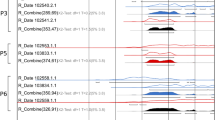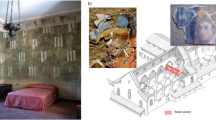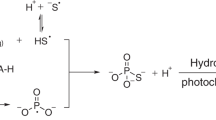Abstract
DATING of prehistoric rock paintings (pictographs) has traditionally relied on indirect evidence. This includes inferences based on the archaeological context, such as superpositions of pictorial styles1 and the depiction of images that constrain their ages1,2, as well as dating of deposits that either cover the art in situ3,4 or contain separated fragments of the painted surface5. Migration of ions between the bulk rock and the natural coatings that form on a newly exposed surface has also been exploited to date petroglyphs (rock carvings) in desert regions6–13. Until recently14–17, however, direct dating (by radiocarbon techniques) of pictographs has not been possible18,19, mainly because of the problem of separating inorganic carbon from the organic material in the pigments. Here we report on a new technique which allows this separation to be effected by using a low-temperature, low-pressure oxygen plasma to oxidize selectively the organic component; this may then be analysed using standard14C methods. We have applied this technique to a portion of a pictograph from the Lower Pecos region of southwest Texas (Fig. 1). The date obtained, 3,865±100 yr BP (before present) is consistent with that expected on the basis of archaeological inference20. As organic carbon is a ubiquitous component of pictograph paints, this technique should be applicable to rock paintings throughout the world.
This is a preview of subscription content, access via your institution
Access options
Subscribe to this journal
Receive 51 print issues and online access
$199.00 per year
only $3.90 per issue
Buy this article
- Purchase on Springer Link
- Instant access to full article PDF
Prices may be subject to local taxes which are calculated during checkout
Similar content being viewed by others
References
Kirkland, F. & Newcomb, W. W. Jr Rock Art of Texas Indians (University of Texas Press, Austin, 1967).
Shafer, H. J. Ancient Texans (Texas Monthly Austin, 1986).
Pfeiffer, J. E. The Creative Explosion (Harper and Row, New York, 1982).
Breuil, A. H. Four Hundred Centuries of Cave Art (Hacker Art Books, New York, 1979).
Sieveking, A. The Cave Artists (Thames and Hudson, London, 1979).
Dorn, R. I. Quat. Res. 20, 49–73 (1983).
Dorn, R. I. & Whitley, D. S. Nature 302, 816–818 (1983).
Dorn, R. I. & Whitley, D. S. Ann. Ass. Am. Geogr. 42, 308–322 (1984).
Dorn, R. I. et al. Science 231, 830–833 (1986).
Dorn, R. I., Tanner, D. B., Turrin, D. & Dohrenwend, J. C. Phys. Geogr. 8, 72–81 (1987).
Dorn, R. I., Turrin, B. D., Jull, A. J. T., Linick, T. W. & Donahue, D. J. Quat. Res. 28, 38–49 (1987).
Whitley, D. S. & Dorn, R. I. World Archaeol. 19, 150–164 (1987).
Nobbs, M. F. & Dorn, R. I. Rock Art Res. 5, 108–146 (1988).
Van der Merwe, N. J., Sealey, J. & Yates, R. S. S. Afr. J. Sci. 83, 56–57 (1987).
Loy, T. H. et al. Antiquity 64, 110–116 (1990).
Lorblanchet, M. et al. Rock Art Res. 7, 4–20 (1990).
Clottes, J., Menu, M. & Walter, P. Rock Art Res. 7, 21–26 (1990).
Leroi-Gourhan, A. Treasures of Prehistoric Art (Abrams, New York, 1965).
Barnes, F. A. Prehistoric Rock Art (Wasatch, Salt Lake City, 1982).
Turpin, S. An Overview of the Radiocarbon Chronology in the Lower Pecos River Region, Tex. Archaeol. Surv. Res. Rep. (University of Texas, Austin, in the press).
Turpin, S. Seminole Canyon, Tex. Archaeol. Surv. Res. Rep. No. 83 (University of Texas. Austin, 1982).
Gleit, C. E. & Hollahan, W. D. Analyt. Chem. 34, 1454–1457 (1962).
Gleit, C. E. Analyt. Chem. 37, 314–315 (1962).
Hollahan, J. R. J. chem. Educ. 43, A401–A416 (1966).
Gluskoter, H. J. J. sedim. Petrol. 37, 205–214 (1965).
De Vries, H. Proc. K. Ned. Akad. Wet. B61, 94–102 (1958).
Deevey, E. S. Jr, Gross, M. S., Hutchison, G. E. & Graybill, H. L. Proc. natn. Acad. Sci. U.S.A. 40, 285–288 (1954).
Dorn, R. I., Jull, A. J. T., Donahue, D. J., Linick, T. W. & Toolin, L. J. Geol. Soc. Am. Bull. 101, 1363–1372 (1989).
Peltier, S. & Duval, C. Analyt. chim. Acta 1, 345–354 (1947).
Hyman, M. & Rowe, M. W. Tex. J. Sci. 42, 55–67 (1990).
Author information
Authors and Affiliations
Rights and permissions
About this article
Cite this article
Russ, J., Hyman, M., Shafer, H. et al. Radiocarbon dating of prehistoric rock paintings by selective oxidation of organic carbon. Nature 348, 710–711 (1990). https://doi.org/10.1038/348710a0
Received:
Accepted:
Issue Date:
DOI: https://doi.org/10.1038/348710a0
This article is cited by
-
Pigments for the dead: megalithic scenarios in southern Europe
Archaeological and Anthropological Sciences (2023)
-
Radiocarbon dating
Nature Reviews Methods Primers (2021)
-
Direct radiocarbon dates for prehistoric paintings at the Altamira, El Castillo and Niaux caves
Nature (1992)
-
14C dating of ancient rock art: A new application of plasma chemistry
Plasma Chemistry and Plasma Processing (1991)
Comments
By submitting a comment you agree to abide by our Terms and Community Guidelines. If you find something abusive or that does not comply with our terms or guidelines please flag it as inappropriate.



